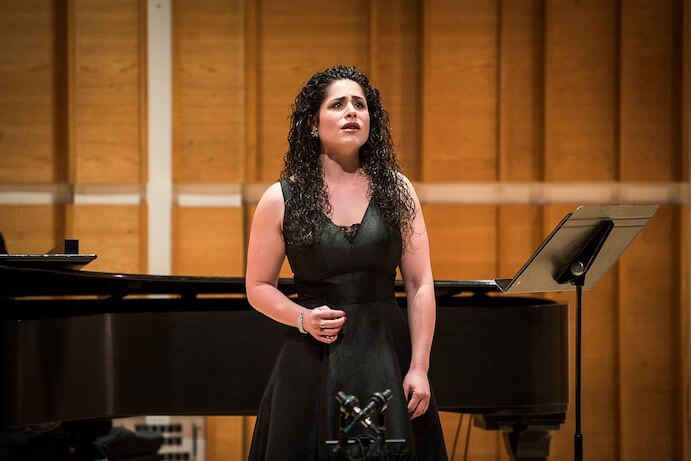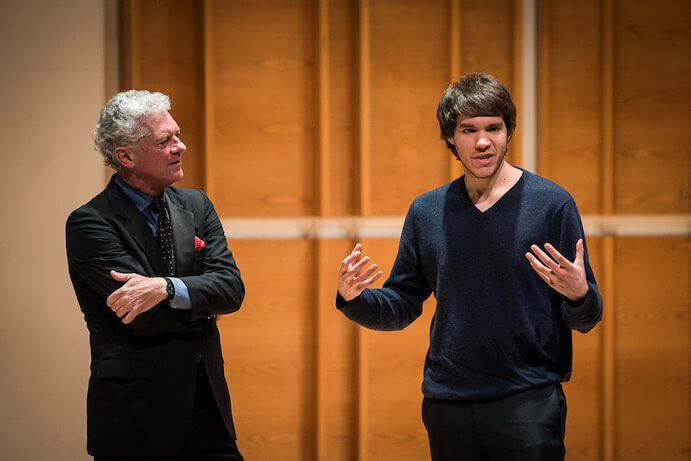On February 20th at Merkin Hall, the New York Festival of Song‘s “Hyphenated-Americans” program featured four composers who work and live in the United States. Among them are first-generation composers and American citizens with close ties to other countries and cultures: Clarice Assad (Brazilian-American), Bright Sheng (Chinese-American), Daniel Sabzghabaei (Persian-American), and Roberto Sierra (Puerto Rican).
The program opened with the world premiere of Clarice Assad’s Prece (Prayer) (2018), followed by her Elementos (2010). Each of the element-infused movements channeled a different character that evoked vibrant qualities often associated with earth, fire, water, and air. One of the standouts was the darkly blooming and modal “Earth—Flor de Lā (Wool Flower).” Steven Blier’s dramatic and improvisatory pianism captured the ever-shifting harmonic colors of the movement. Alexandra Urquiola’s liquid mezzo and striking performance of “Water—Maré de Água Viva (A Tide of Living Water)” fell at the sublime confluence of sorrow and peace.

Bright Sheng’s Three Chinese Love Songs (1988) were the oldest and most successful pieces on the program. Soprano Amy Owens sang with a bright exaltation that emphasized the buoyant flex of Sheng’s writing. The ensemble, which included pianist Michael Barrett and violist Tien-Hsin (Cindy) Wu, gave ample space for the musical gestures to flow without constraint. Sheng’s clear command of narrative made for a set of tight and engaging pieces that, far from overstaying their welcome, left me with the desire to hear more.
Daniel Sabzghabaei’s At The Door (2017) set Rumi’s “Ghazal 436” for two voices: the Lover (Owens) and the Beloved (Jesse Blumberg). In this intimate scene, the piano was arranged to face the audience straight on. The lid was propped open with an extra-long stick, so that it was raised to a near vertical wall (or “door”) that separated the pair of vocalists. Much of Sabzghabaei’s writing resembled a recitative, with icicle-like chords on the piano piercing through the backdrop of a low and resonant din. The themes of Ghazal 436 include intimacy, sensuality, and nearly-but-not-quite-achieved unification, which Sabzghabaei brought out clearly in his setting of the text.

The second half of the concert was devoted to the U.S. premiere of Roberto Sierra’s epic 33 Sueños (33 Dreams) (2018). The fifty-minute piece was a true test of endurance, yet Blumberg and pianist Leann Osterkamp stayed cool and maintained a focused energy through every tumultuous and tender movement. Blumberg’s dramatic baritone was commanding and declamatory, with sensitive shifts in color that added a subdued drama in quieter moments. Osterkamp’s fiery and translucent touch at the piano was dazzling. However with thirty-three short movements to summit, and a tireless sturm und drang character, 33 Sueños is a difficult sell. While there were standout moments (such as a surprisingly lyrical and placid movement near the end), the piece as a whole struggled to sustain a narrative pull.
Brief on-stage interviews with the composers throughout the evening included some questions about the influence of culture on compositional practice. However, the short format did not leave much room for nuanced discussion. When asked if he continues to draw upon his Chinese heritage in composition, Sheng thought for a long moment before answering “yes,” implying that the real answer was much longer and more complicated than they had time for. I couldn’t help but wonder if there was a better format for the type of discourse the New York Festival of Song was interested in exploring—or perhaps, that their programming decisions alone were enough to make a statement. Either way, “Hyphenated-Americans” was a well-performed and refreshing representation of contemporary American classical vocal music.
























